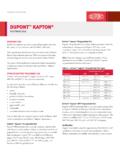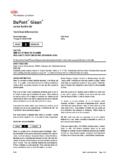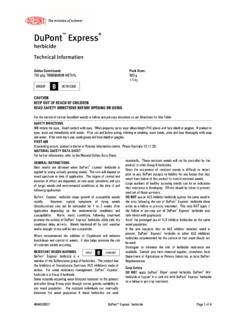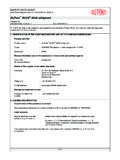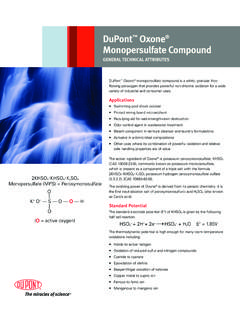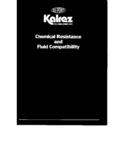Transcription of EHS Organizational Quality: A DuPont Case Study
1 Major environmen-tal, health, andsafety (EHS) organi-zational restructur-ings have been, forthe most part, man-aged by default that is, driven bybroader business re-organizations and financial considerations,rather than by self-initiated efforts by EHS se-nior mid- to late 1990s were a particularlyturbulent time for EHS organizations. Viewed asservice providers ( , overhead) by businessmanagement, they were caught up in wave afterwave of restructurings that outsourced and/orconsolidated these activities into shared fever has tapered off more re-cently, and, over the past five years, managershave fine-tuned their organizations to repairsome of the bad calls made during this aggressiveperiod of service restructurings.
2 But, if anything,the pressure placed on EHS departments to domore with less has only are today s best practices? The recent re-tirement of Paul Tebo, Vice President of Safety,Health & Environment (SHE) at DuPontprompted the company to rethink its EHSorganizational considered oneof the best EHS organizations in industry, whatcould it do toimprove?About ThisResearchFor the past sev-eral years, the Cen-ter for Environmen-tal Innovation hasbeen examining the characteristics of high-per-forming environmental, health, and safety organ-izations.
3 Called Organizations in Transition, the focus of the work has been on large corpora-tions because these generally have the most ma-ture Organizational of their size and their layered struc-ture (encompassing the corporate, business groupor sector, and facility levels), large corporationscan also afford a window into best practices forsmall- to medium-sized enterprises (SMEs).The classic Organizational elements (such assize, structure, and communication links) arebeing evaluated for their capacity to efficientlydeliver services of high value to business.
4 In otherwords, is an organization able to achieve an ap-propriate blend of what the customer desires andrequires, and at an optimum cost?The identity of the customer varies consid-erably depending on whether one is consideringEnvironmental Quality Management/ Winter 2004 / 19 2004 Wiley Periodicals, online in Wiley InterScience ( ).DOI: MacLeanEHS OrganizationalQuality: A DuPont CaseStudyBest practices in corporateenvironmental, health, andsafety Organizational designRichard MacLean20/ Winter 2004 / Environmental Quality Managementthe wants and needs of the board of directors, amarketing manager, or a plant manager.
5 In addi-tion, the concept of meeting customer wants andneeds has taken on added dimensions that in-clude the ability to deal effectively with emergingstakeholder issues driven typically by nongovern-mental organizations (NGOs).The challenge, of course, is to get the blendright. That s what this research is date, this effort has produced journal arti-cles on the evolution of EHS Organizational strat-egy,2the definition of superior organizationalperformance,3a screening protocol for high-per-forming organizations,4and the growing influ-ence of NGOs on hasalso produced an in-terim information onthis research can beobtained at Methodology and Basis forComparisonA number of trade associations, professionalsocieties.
6 And industry sector company allianceshave collected survey information on organiza-tional structure and staffing size. In most cases,however, the results of these studies are availableonly to survey exclusivity of these studies may give theimpression of value. But, for the most part, it isextremely difficult to interpret the results accu-rately. Much about an organization s design isrelated to subjective issues such as the influenceof company culture, business objectives, pro-ductivity, and even personality and legacy is-sues.
7 These rarely are captured in a fill in theblanks have found that the only reliable way toprobe an organization is through face-to-face (or,at a minimum, telephone) interviews with safety group may be separate fromthe environmental group because it truly repre-sents best practice for that particular company or it just may be a reflection that Joe cannot getalong with Jane. Questionnaires cannot reli-ably uncover this type of author s own experience (working as aconsultant to companies undergoing reorganiza-tion) has revealed that legacy issues, individualpersonalities, and/or dysfunctional group behav-ior can be the driving forces behind many orga-nizational decisions.
8 This statement applies to allorganizational departments, not just information for this case Study was gath-ered during a daylong visit to DuPont s corporateheadquarters in Wilmington, Delaware, in August2004. Several EHS senior staff members were in-terviewed, and there were a number of follow-uptelephone calls and e-mails to verify ad-dition, the author has interviewed a number ofsenior DuPont EHS staff members over the yearsfor various client benchmarking projects. Theseinterviews helped to provide a historical perspec-tive on DuPont s Organizational interview protocol was based on the spec-trum of essential management systems for EHSand social responsibility.
9 DuPont was selected be-cause it was ranked first by a wide margin in a se-lection protocol that was developed as part of theOrganizations in Transition research company s recent reorganizations and high-profile governance issues (discussed later) werecoincidental and were not the basis for the selec-tion of DuPont , although they added to the valueof the case judgments on EHS Organizational bestpractice are based on an extensive literaturesearch, ongoing interviews with other companiesidentified as best in class, and the author s di-rect experience in supporting companies under-going Organizational have found that the only reliableway to probe an organization isthrough face-to-face (or, at aminimum, telephone)
10 Interviewswith staff Quality Management/ Winter 2004 / 21 EHS Organizational Quality: A DuPont Case Studyearly 1990s, in keeping with its overall company underwent a major restructur-ing in 1993, during which its five major busi-ness sectors were replaced with 23 highly au-tonomous strategic business units (SBUs). Theworkforce was cut by a third, and the corporateservice functions (such as human resources,EHS, finance, and information technology)were given the mandate to be as cost-effectiveas outside service providers.

